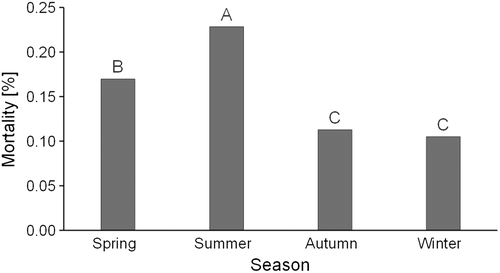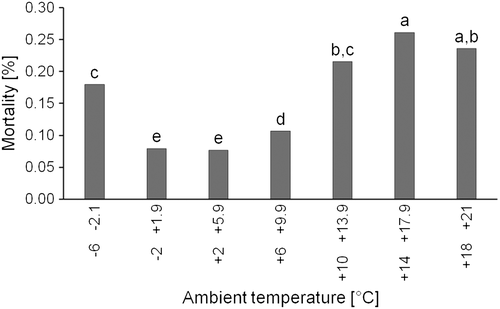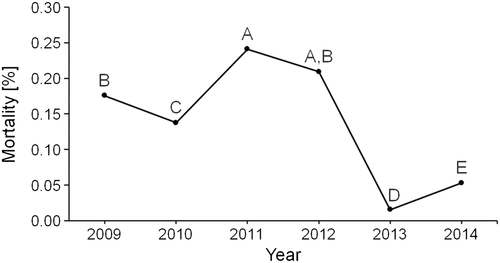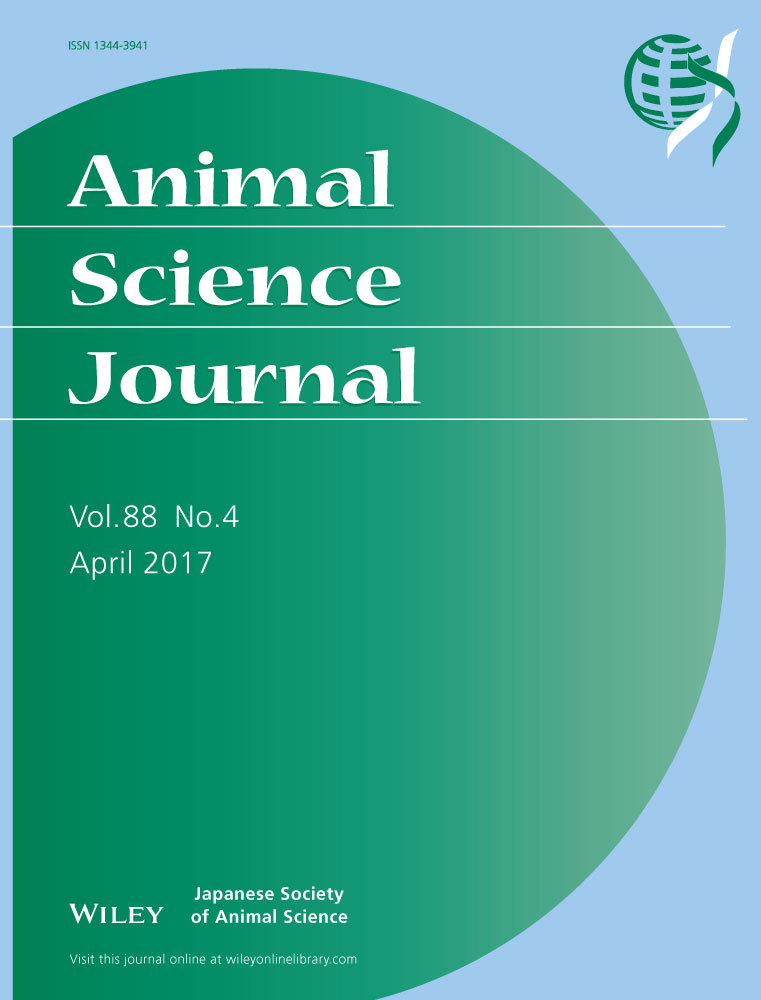Pre-slaughter mortality among turkeys related to their transport
Abstract
Overall mortality among turkeys transported for slaughter in the Czech Republic from 2009 to 2014 was 0.147%. The lowest mortality (0.023%) was found in turkeys transported for distances up to 50 km; longer distances were associated with increasing death rates, with the highest losses (0.543%) recorded for distances from 201 to 300 km. Differences were also found when comparing transport-related mortality rates according to the season of the year. The highest mortality (0.228%) was associated with transports carried out in summer, whereas the lowest death rates were found in turkeys transported for slaughter in winter (0.105%) and autumn (0.113%). According to the ambient temperatures in which transports associated with the highest death rates among turkeys were carried out (14 to 21°C), it appears that heat stress can be a major factor in the birds’ mortality. However, low ambient temperatures (i.e. below −2°C) also appear to increase transport-related mortality, as shown by our results. In addition to shortening the lengths of transport distances, appropriate consideration of prevailing climatic conditions and the sensitivity of turkeys to high and low temperatures during transport may also lead to a reduction in the number of turkeys dying during transport for slaughter.
Introduction
During transport for slaughter, poultry is exposed to many potential stress factors that may induce unfavorable effects on individuals, ranging from mild discomfort to death (Knowles & Broom 1990; Nicol & Scott 1990). The stress factors to which poultry is exposed during transport include unfavorable microclimatic conditions in the cargo area of the vehicle; vehicle acceleration, vibration, motion and tremor; starvation and transport without access to water leading to weight loss; the disruption of social groups; and the presence of noise (Mitchell & Kettlewell 1998; Nijdam et al. 2004; Doktor & Poltowicz 2009; Khosravinia 2015; Jiang et al. 2016). The general handling of birds also has an effect on the welfare of poultry before slaughter. Prescott et al. (2000) discovered that turkeys caught by the wings or legs had a higher heart rate and higher occurrence of injury than turkeys handled with an automatic loader. The more considerate handling of birds reduces the risk of trauma and reduces poultry deaths occurring as a consequence of injuries such as hemorrhaging, abrasions and fractures (Nijdam et al. 2004). Transport-related mortality in poultry species other than broiler chickens has been studied little so far and no recent data are available. Bayliss and Hinton (1990) and McEwen and Barbut (1992) discovered a high level of lethal injuries in turkeys sustained during handling and transport. Voslarova et al. (2007a) reported an overall mortality of 0.279% in turkeys during transport for slaughter in the Czech Republic during the period 1997–2006. Petracci et al. (2006) reported the average incidence of death on arrival (DOA) to be 0.38% in turkeys transported to Italian poultry processing plants. The welfare of turkeys during transport may also be influenced by transport distance and the duration of transport. Voslarova et al. (2006) found that transport-related mortality in turkeys increased significantly with the increasing length of transport.
Another factor influencing turkey mortality during transport may be the external air temperature, which is dependent on the season of the year. Ambient temperature affects the microclimate in the trailer but critical values for turkeys have not so far been assessed. The effect of ambient temperature and relative humidity should be considered in different seasons of the year and in different regions, since it may differ geographically. Petracci et al. (2006) found preslaughter mortality in turkeys transported to Italian poultry processing plants in summer to be dramatically higher (+59%) than the respective averaged mortality observed in autumn, winter and spring. In contrast, Voslarova et al. (2006) reported the highest transport-related mortality in winter months (i.e. December, January and February).
Transport-related mortality in poultry is not merely an indicator of shortcomings in the welfare levels during loading, transport and unloading, but also represents a significant economic loss (Knowles & Broom 1990; Nijdam et al. 2004; Bianchi et al. 2005; Petracci et al. 2006; Wichman et al. 2010; Wichman et al. 2012). Furthermore, poor welfare during transport may result in deteriorated turkey meat quality (Owens & Sams 2000; Doktor & Poltowicz 2009), including an increased occurrence of PSE (pale, soft, exudative) meat in turkeys (Sosnicki et al. 1998; Barbut et al. 2008; Spurio et al. 2016; Xing et al. 2016), the rejection of turkey carcasses following post mortem inspection (Lupo et al. 2010), the rejection of turkey meat due to cyanosis (Mallia et al. 2000a, 2000b, 2000c) and injuries resulting from mutual pecking (Dalton et al. 2013; Duggan et al. 2014).
Rules for the commercial transport of turkeys in the Czech Republic (as a member state of the European Union) are laid down by the Council Regulation (EC) No 1/2005 of 22 December 2004 on the protection of animals during transport and related operations and amending Directives 64/432/EEC and 93/119/EC and Regulation (EC) No 1255/97 (Council of the European Union 2005). Responsibility for the welfare of animals is clearly defined at each stage of transport. The regulation also provides that the competent authority is to check that the requirements of that Regulation have been complied with, by carrying out non-discriminatory inspections of animals, means of transport and accompanying documents.
The aim of the present study was to assess mortality related to the commercial transport of turkeys for slaughter in the Czech Republic, and to determine the effect of transport distance and season (external air temperature) on turkey mortality.
Materials and Methods
Data collection
In the period from 2009 to 2014, the welfare of turkeys transported to slaughterhouses in the Czech Republic was monitored. The inspectors of the State Veterinary Administration of the Czech Republic recorded the numbers of turkeys transported to the slaughterhouse for slaughter. They recorded the mortality in these turkeys in relation to transport, that is the number of turkeys dying directly during transport or dying at the slaughterhouse after transport but before slaughter. The transport of turkeys from farms to slaughterhouses was carried out by means of road transport using trucks specifically designed for transportation of poultry. The transport conditions for all journeys were in compliance with Council Regulation (EC) No 1/2005 of 22 December 2004 on the protection of animals during transport and related operations and amending Directives 64/432/EEC and 93/119/EC and Regulation (EC) No 1255/97 (Council of the European Union 2005). Data for the whole Czech Republic were collected in database form at the Information Centre of the State Veterinary Administration. The data were analyzed using a program IS SVS – modul Klient that generated reports about the numbers of transported turkeys that died under particular conditions and converted them into Excel format for further statistical processing.
Determining the impact of transport distance
The impact of transport distance on turkey mortality in the context of transport to the slaughterhouse was determined according to the following intervals: up to 50 km, from 51 km to 100 km, from 101 km to 200 km, from 201 km to 300 km, and above 300 km. For the period from 2009 to 2014, the annual numbers of turkeys transported over these transport distances and the respective numbers of turkeys that died were recorded in absolute numbers, and the mortality rates calculated in percentages.
Determining the impact of season
The seasonal impact – defined by the four seasons: spring (March, April, May), summer (June, July, August), autumn (September, October, November) and winter (December, January, February) – on mortality among turkeys during their transport to processing plants was determined by calculating the total numbers of turkeys transported and the total numbers of turkeys that died during particular seasons over the whole monitored period, and by calculating the respective mortality rates for those seasons in percentages.
Determining the impact of ambient temperature
In order to assess the impact of ambient temperature on the mortality of turkeys during their transport to processing plants, ambient temperatures for individual transports were determined in cooperation with the Czech Hydrometeorological Institute, Prague, Czech Republic. The Czech Hydrometeorological Institute collects meteorological and climatological measurements from its network of 802 stations located over the territory of the Czech Republic. Retrospective data on ambient air temperatures related to the times and locations of transports monitored in our study were obtained from the archives. In the monitored period, the ambient temperature under which transports were carried out ranged from −6 to 21°C. For the purposes of our study, all turkey transports were divided into intervals of −6 to −2.1°C, −2 to 1.9°C, 2 to 5.9°C, 6 to 9.9°C, 10 to 13.9°C, 14 to 17.9°C and 18 to 21°C. For these intervals, the numbers of turkeys that were transported and the numbers of turkeys that died during the monitored period were recorded in absolute numbers and the mortality rates calculated in percentages.
Statistical analysis
Data were analyzed using the Unistat v. 6.5. statistical package (Unistat Ltd., London, England). Statistical comparisons between the frequencies of the categorical variables of interest were performed using the Chi-square test (with Yates correction) within the 2 × 2 contingency table procedure (Zar 1999). When the frequencies in the contingency table were lower than five, a Fisher exact test was used instead of the Chi-square test. For the whole period from 2009 to 2014, data concerning transport-related mortality rates in turkeys were compared between individual years and transport distances, and between seasons and ambient temperature intervals. A P-value of 0.05 in tests was considered significant.
Results
Turkey transport and transport-related mortality
A total of 762 789 turkeys were transported for slaughter in the Czech Republic in the monitored period, of which 1125 (0.147%) died from causes connected with transport. The number of turkeys transported to poultry processing plants in the Czech Republic and the number of birds dying as a result of their transport for each of the monitored distance intervals are given in Table 1. During the monitored period, there was an overall fall in the number of turkeys transported and a decline in the transportation of turkeys over the larger distances that have been associated with higher transport-related mortality in previous studies.
| Distance (km) | 2009 | 2010 | 2011 | 2012 | 2013 | 2014 | |
|---|---|---|---|---|---|---|---|
| Number of turkeys | |||||||
| <50 | Transported | 91 898 | 90 778 | 64 483 | 56 171 | 61 606 | 74 274 |
| Dead | 21 | 17 | 25 | 11 | 3 | 24 | |
| 50–100 | Transported | 47 465 | 19 989 | 18 513 | 6394 | 19 183 | 25 225 |
| Dead | 103 | 65 | 34 | 31 | 8 | 28 | |
| 101–200 | Transported | 37 927 | 18 361 | 21 687 | 12 313 | 9596 | 3943 |
| Dead | 121 | 37 | 85 | 69 | 3 | 3 | |
| 201–300 | Transported | 20 076 | 21 964 | 26 637 | 6329 | 550 | 0 |
| Dead | 91 | 90 | 170 | 59 | 0 | 0 | |
| 300 < | Transported | 4450 | 665 | 2312 | 0 | 0 | 0 |
| Dead | 19 | 0 | 8 | 0 | 0 | 0 | |
Impact of transport distance
Transport-related mortality rates among turkeys for the transport distance intervals monitored in our study are presented in Figure 1. The lowest mortality (0.023%) was found in turkeys transported for distances up to 50 km; longer distances were associated with increasing (P < 0.001) death rates, with the greatest losses (0.543%) recorded for distances from 201 to 300 km.

Impact of season
The transport-related mortality of turkeys as affected by season of the year is shown in Figure 2. The highest mortality (0.228%) was associated with transports carried out in summer months; lower (P < 0.001) transport-related mortality was found in spring months (0.170%). The lowest death rates were found in turkeys transported for slaughter in winter (0.105%) and autumn (0.113%) months, with no statistically significant difference found between them. However, transport-related mortality rates in both winter and autumn were lower (P < 0.001) in comparison to mortality rates found in summer and spring.

Impact of ambient temperature
The impact of ambient temperature on the transport-related mortality of turkeys is shown in Figure 3. Transports carried out under ambient temperatures from 14 to 17.9°C were associated with the highest death rates among turkeys (0.261%). Lower (P ˃ 0.05) mortality (0.236%) was found in the transport of turkeys at temperatures of 18 to 21°C (the highest temperatures observed in our study). The lowest death rates were found in turkeys transported for slaughter under ambient temperatures from −2 to 1.9°C (0.079%) and 2 to 5.9°C (0.077%). The lowest temperatures observed in our study (−6 to −2.1°C) were associated with higher (P < 0.001) death rates (0.179%) in comparison to temperature intervals from −2 to 9.9°C.

Trends in transport-related mortality
The trend in transport-related mortality in turkeys in the period from 2009 to 2014 is shown in Figure 4. While the total numbers of birds transported for slaughter in the Czech Republic were decreasing in the monitored period, the numbers of birds dying as a result of their transport to processing plants varied widely, and differences (P < 0.001) were found when comparing transport-related mortality rates in individual years. The highest mortality was found in 2011 (0.241%), whereas the lowest mortality in turkeys transported for slaughter was in 2013 (0.015%), with a subsequent increase (P < 0.001) in transport-related turkey mortality in 2014 (0.053%).

Discussion
Pre-slaughter handling is stressful to poultry. The stress factors acting on individual birds during handling and transport result in changes to their biochemical, hematological and hormonal profiles, a weakened immunity, and an increased risk of infection (Vosmerova et al. 2010; Wichman et al. 2010; Voslarova et al. 2011; Khosravinia 2015). Turkeys are exposed to an increased risk of injury during capture and loading into crates (Doktor & Poltowicz 2009). Incommensurate capture and handling have negative impacts on welfare, from mild stress to the death of the individual (Marchewka et al. 2013). Bayliss and Hinton (1990) discovered that as many as 35% of deaths in broilers during transport are caused by injury during capture and transport. The high incidence of injuries and deaths during transport represent a considerable loss to the poultry industry. In the present study, mortality related to the commercial transport of turkeys for slaughter in the Czech Republic was assessed.
The overall mortality of turkeys transported for slaughter in the Czech Republic from 2009 to 2014 was 0.147%. This is about half of the turkey transport-related mortality rates found in earlier studies (Petracci et al. 2006; Voslarova et al. 2006, 2007a). The results suggest that, in general, conditions under which turkeys are transported for slaughter have improved over the years. This might be caused by the tightening of requirements for animal transportation by means of the relevant legislation (the Council Regulation (EC) No 1/2005 of 22 December 2004 on the protection of animals during transport and related operations and amending Directives 64/432/EEC and 93/119/EC and Regulation (EC) No 1255/97), which came into force on 5 January 2007. However, the individual transport-related mortality rates analyzed in our study varied widely. They ranged from 0.023% to 0.543%, the increase approximately corresponding to increasing transport distance. A similar trend has also been identified in other studies analyzing poultry transport in, for example, broiler chickens (e.g. Warriss et al. 1992; Bianchi et al. 2005; Vecerek et al. 2006; Aral et al. 2014; Vecerek et al. 2016), hens and cockerels (Voslarova et al. 2007a, 2007b), ducks and geese (Voslarova et al. 2007a) and other livestock (e.g. Malena et al. 2007). The effect of transport distance in turkeys has only previously been studied by Voslarova et al. (2006, 2007a), who came to similar conclusions. They found the lowest mortality rates for the shortest transport distances and the highest mortality rates for transport distances of over 200 km. Our results show lower mortality rates for shorter transport distances of up to 50 km in comparison to the earlier study (0.023% vs. 0.164%). However, we found that turkey mortality for distances of over 200 km was higher in recent years in comparison to the earlier study (0.543% vs. 0.341%). From 2009 to 2014, only 11% of turkeys were transported over a distance of more than 200 km. The possible reason for higher death rates among turkeys over transport distances greater than 200 km from 2009 to 2012 may be an underestimation of the importance of ensuring specific conditions when transporting birds over longer distances. Another reason might be a lack of adequate equipment as well as a lack of expertise on the part of breeders or hauliers when preparing for, or conducting such transports. Altogether, this may also be why a reduction in the number of turkeys transported over large distances was seen during the monitored period. Only 550 turkeys (with no mortalities) were transported over a distance of more than 200 km in 2013, and no turkeys were transported over a distance of more than 200 km in 2014. Furthermore, 58% of all turkeys transported for slaughter in the Czech Republic during the entire monitored period were transported over a distance not exceeding 50 km – the distance associated with the lowest mortality rate.
The external air temperature, dependent on the season of the year in which turkeys are transported, is a factor to which less attention has been devoted, and the findings of the two existing studies are contradictory. Petracci et al. (2006) found a significantly higher mortality rate in turkeys transported to Italian poultry processing plants in summer (0.52%) when compared to the mortality rates in autumn, winter and spring, which did not differ markedly from one another (0.29, 0.29 and 0.32%, respectively). Thus, the authors identified heat stress due to high environmental temperatures and high levels of relative humidity (the average minimum–maximum air temperature and relative humidity observed during the summertime being 16.3–27.7°C and 72.7%, respectively) as a major factor in the death of birds during preslaughter time, while low ambient temperatures were considered to be less detrimental to turkeys in terms of transport-related mortality. In contrast, Voslarova et al. (2006) reported the highest transport-related mortality among turkeys in winter months. Considering the temperatures at which the turkeys were transported, the authors concluded that the increase in mortality was associated particularly with lower temperatures during winter, when the average ambient temperature drops to below 0°C and the exposure of birds to such low temperatures has a negative effect on their welfare during transport. Also, temperatures above 15°C tended to increase the mortality rates. However, the highest monthly ambient temperature found by Voslarova et al. (2006) was 16.9°C, and thus the effect of high temperature on transport-related mortality in turkeys could not be assessed. Nevertheless, the authors established the general dependence of turkey mortality rate during transportation on average temperature in individual months (r = 0.62). Increased mortality was associated with a decrease/increase in the average temperature during transportation, as compared to the average annual temperature. In our present study, a similar trend was seen. The highest mortality (0.228%) was associated with transports carried out in summer months; significantly lower transport-related mortalities were found in spring, winter and autumn months (0.170%, 0.105% and 0.113%, respectively). This result, opposite in terms of seasonal effect to that found by Voslarova et al. (2006), can be explained by a shift in ambient temperatures in the Czech Republic over the years. While the average monthly ambient temperatures ranged from −2.6 to 16.9°C in the period from 1997 to 2004, in our present study analyzing the period from 2009 to 2014, a wider range of ambient temperatures was found (−6 to 21°C). Not surprisingly, both the highest and lowest temperatures were associated with increased transport-related mortality among turkeys, with the highest death rates associated with temperatures from 14 to 21°C. The lowest death rates were found in turkeys transported for slaughter under ambient temperatures from −2 to 5.9°C. Our results correspond to those of Nijdam et al. (2004), who found a significant increase in mortality in poultry during transport at temperatures greater than 15°C and less than 5°C. Although our study did not identify serious effects of sub-zero temperatures on transport-related mortality, due consideration must also be given to the possible impact of low temperatures on meat quality. Mallia et al. (2000b) demonstrated the influence of sub-zero temperatures during handling and transport on the occurrence of cyanosis in turkeys, which is one of the principal causes of the rejection of turkey carcasses at the slaughterhouse. In view of the anticipated increase in temperature extremes in the future (Gobiet et al. 2013; Christidis et al. 2014), it will be necessary to alter transport conditions accordingly. The transporter should take into account the expected outside temperature during transport and adjust the loading density. In hot weather, journeys of long duration should be avoided and, if possible, any journeys should be carried out in the morning or evening, when temperatures are lower. Birds should not be left in a stationary vehicle for any length of time.
Transport-related mortality is an indicator of the level of welfare during transport and has an effect on production effectivity. In view of the findings of this study, continued innovation in the methods relating to the capture, handling and transport of turkeys, as well as in the housing of turkeys at the slaughterhouse is necessary in order to improve conditions during the entire process. Shortening the lengths of transport journeys and ensuring suitable microclimatic conditions in the vehicle with a view to the season of the year and the external air temperature at which the transportation is carried out are among the key factors that may make a significant contribution to reducing the number of turkeys dying during transport for slaughter.




